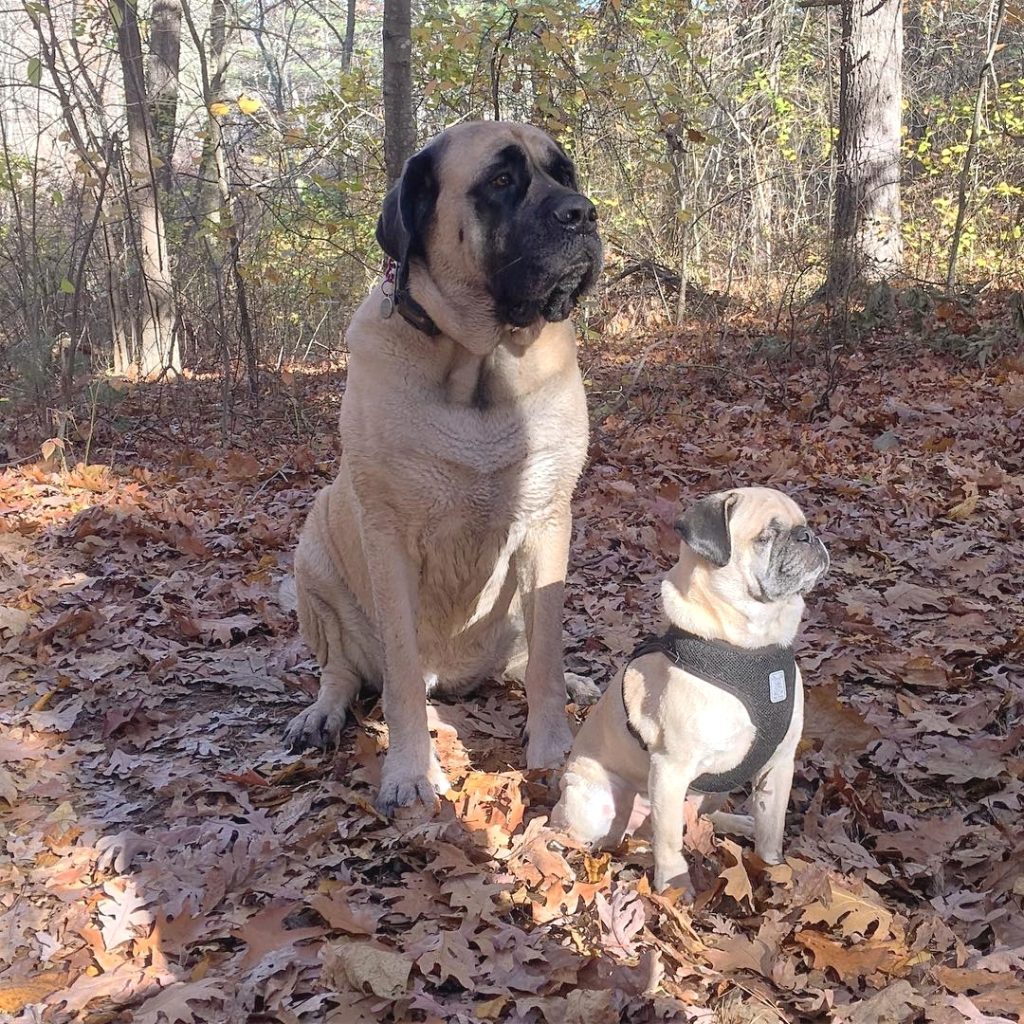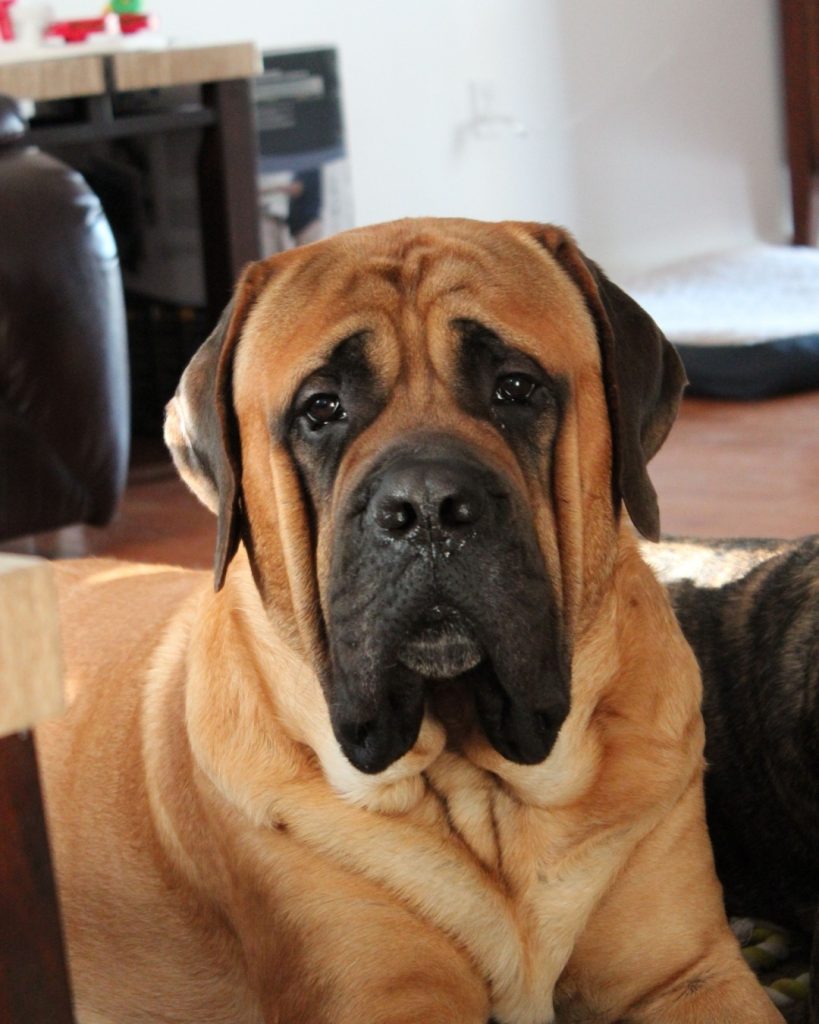Embarking on the journey to training an English Mastiff, a breed distinguished by its majestic size and amiable nature, is both a responsibility and a profound experience. These dogs, known for their colossal stature and gentle disposition, require a specialized approach to training. This introductory section of the article sheds light on the crucial importance of training for English Mastiffs and outlines the primary goals to guide these gentle giants toward becoming well-mannered and obedient companions.

Importance of Training
Training an English Mastiff is not just a matter of obedience but a crucial aspect of their integration into family and society. Given their impressive size – often weighing over 200 pounds – and inherent protective instincts, these dogs can unintentionally become overbearing or even dangerous if adequately trained. The significance of training lies in molding their natural behaviors and tendencies in a way that promotes safety, socialization, and a harmonious living environment. Proper training ensures these dogs can distinguish between genuine threats and everyday occurrences, thereby curbing any overprotective reactions from their instinct to guard.
Due to its sheer size and strength, an untrained Mastiff can pose challenges in handling, especially in public or crowded spaces. Training becomes imperative to prevent accidental harm or overwhelming situations for the dog and the people around. It also helps establish a bond of mutual respect and understanding between the Mastiff and its owner, which is essential given the breed’s sensitive and perceptive nature.
Overview of Training Goals
The task to train a mastiff encompasses several key objectives, each aimed at leveraging their innate qualities while ensuring they become well-adjusted family members. The primary goals include:
- Basic Obedience: Instilling fundamental commands such as ‘sit,’ ‘stay,’ ‘come,’ and ‘heel.’ This forms the foundation of their training, enabling better control and communication between the Mastiff and its owner.
- Socialization: Exposing the Mastiff to various environments, people, and other animals from a young age. This helps develop their confidence, reduce anxiety in new situations, and minimize aggressive or fearful responses to unfamiliar stimuli.
- Leash Training: Essential for a breed of this size, leash training ensures that the Mastiff learns to walk calmly beside its owner without pulling or becoming uncontrollable, which is vital for the dog’s and the public’s safety.
- Behavioral Management: Addressing and correcting undesirable behaviors like jumping, excessive barking, or destructive chewing. This also involves teaching them appropriate ways to interact with people and other animals.
- Advanced Commands and Skills: Depending on the individual dog’s temperament and the owner’s requirements, training can extend to more advanced skills, including specialized commands, agility training, or even therapy and assistance roles.
Understanding Your English Mastiff
Origins and History
The English Mastiff’s lineage is steeped in history, tracing to ancient times. Initially bred for guarding and protection, they have played roles in various historical contexts, from war dogs to estate guardians. Understanding this rich heritage is crucial in appreciating their natural guarding instincts and loyalty.
Appearance and Abilities
The English Mastiff is a breed that commands attention with its impressive size and robust build. Typically, they possess a powerful and muscular physique, with males often weighing over 200 pounds. Despite their formidable appearance, Mastiffs are renowned for their gentle and affectionate nature. Their abilities lie more in their strength and endurance than speed, making them excellent guardians rather than hunting or herding dogs. Understanding their physical attributes and inherent capabilities is vital in tailoring training methods that respect their nature while effectively guiding their behavior.
Temperament and Tendencies
The temperament of the English Mastiff is a blend of nobility, patience, and loyalty. Known for their calm and composed demeanor, they form strong bonds with their families, often being gentle and protective, especially around children. However, they can also display a stubborn streak, which can pose challenges in training. Recognizing and understanding these tendencies is crucial in developing a practical training approach that respects their nature.
Fundamentals to Start Training a Puppy

Age For Start Training
The ideal time to dog training is as early as possible, typically when they are puppies. This early stage is crucial for imprinting positive behaviors and establishing foundational training principles. Starting young allows for easier management of their large size as they grow and facilitates better learning and retention of training lessons.
Training Challenges with Mastiffs
Obedience training comes with unique challenges. Their massive size can make handling difficult, especially if they are not trained to obey commands early on. Additionally, their protective nature can sometimes manifest as overprotectiveness, requiring careful training to ensure they do not become overly aggressive. The breed’s tendency towards stubbornness can also make training a test of patience and consistency. It’s essential to approach these challenges with a clear strategy and adaptability.
Training Philosophy
Start training with patience, consistency, and positive reinforcement. Harsh or punitive methods are ineffective and can harm the dog’s and the owner’s bond. Instead, focus on rewarding good behavior to encourage repetition. Establishing yourself as a calm and assertive leader is critical to gaining their respect and trust. Training should be a mix of firmness and affection, recognizing the Mastiff’s sensitive nature. Keeping training sessions short, engaging, and varied is vital to maintain their interest and prevent boredom.
Basic Information To Know To Train a Mastiff: How to Socialize and Teach your Dog
Basic training for an Mastiff is crucial in shaping them into well-mannered pets. This training includes socialization, obedience, leash training, and house training.
Socialization
- Introduce to Different Environments: Expose them to various settings like parks, city streets, and crowded places.
- Meet Diverse People and Animals: Allow interactions with different people and pets to build confidence.
- Positive Experiences: Ensure each new encounter is pleasant and non-threatening.
Basic Obedience Commands for Mastiffs
- Sit: Essential for control and calmness.
- Stay: Teaches patience and self-control.
- Come: Important for safety and recall.
- Down: Useful for managing size and vitality.
- Heel: Keeps them close during walks.
Leash Training
- Familiarization with Leash: Let them get used to the leash by wearing it around the house.
- Short, Controlled Walks: Begin with brief walks in a quiet area.
- No Pulling: Reinforce walking without pulling through rewards for calm behavior.
- Consistent Commands: Use clear and consistent commands to guide them.
House Training
- Regular Bathroom Schedule: Establish a consistent routine for bathroom breaks.
- Designated Bathroom Area: Choose a specific spot outside for elimination.
- Positive Reinforcement: Reward them for using the correct spot.
- Supervision and Management: Watch for signs they need to go and prevent accidents inside.
Each aspect of basic training ensures your Mastiff grows into a well-adjusted and obedient companion.
Mastiff Training Tips Considering Behavior Management

Behavior management in English is crucial due to its size and strength. Issues like biting, jumping, lunging, and chewing need to be addressed with thoughtful training techniques.
Biting Prevention
Biting, especially in puppies, can be natural but must be curbed early. The key steps include:
- Redirection: When a puppy bites, redirect their attention to a toy or chewable item.
- Consistent Response: Always respond to biting the same way to reinforce that it’s unacceptable.
- Positive Reinforcement: Praise them when they chew on appropriate items.
Jumping and Lunging:
Due to their size, jumping and lunging can be intimidating and potentially harmful.
- Ignoring the Behavior: Do not give attention when they jump. Turn away or walk off to show that jumping won’t result in affection or attention.
- Command Training: Use commands like ‘sit’ to manage their jumping impulse.
- Reward Calm Behavior: Reinforce calm greetings with treats and praise.
Chewing
Chewing is a common issue in Mastiffs, especially during teething.
- Provide Appropriate Chew Toys: Ensure they can access suitable items to satisfy their chewing urges.
- Discourage Chewing on Inappropriate Items: If they chew on something, they shouldn’t calmly redirect them to an appropriate item.
- Exercise and Mental Stimulation: Regular physical activity and mental challenges can reduce boredom-related chewing.
The key is to be consistent and patient in each of these areas. Mastiffs can be stubborn, so repeating training exercises and maintaining calm will help instill these behaviors more effectively. Understanding that these behaviors are often a result of their environment, boredom, or lack of exercise is crucial. Providing enough physical activity, mental stimulation, and appropriate outlets for their natural tendencies will go a long way in managing these behaviors.
Remember, the right training requires time, patience, and consistency. Addressing each behavior issue individually and with a clear strategy will ensure that your Mastiff grows into a well-behaved and balanced adult dog.
Advanced Training Concepts
Advanced training concepts for Mastiffs encompass crate training, maintaining consistency in training, and managing training session lengths. These elements play a crucial role in their overall development and behavior.
Crate Training
Crate training is a valuable tool for Mastiffs, providing them with a safe space and aiding in house training and behavior management. A crate should be considered a positive and comfortable place for the dog. Here’s a brief guide:
| Age Range | Crate Time Duration | Notes |
| 8-10 weeks | 30-60 minutes | Puppies have limited bladder control and need frequent breaks. |
| 2-3 months | 1-2 hours | Gradually increase time as they get accustomed. |
| 4-6 months | 2-4 hours | Ensure they have toys and are comfortable. |
| 6+ months | 4+ hours (not to exceed 6 hours) | Should be well-adjusted to the crate by this age. |
Consistency in Training
Consistency is paramount when it comes to training. It involves:
- Regular Practice: Training should be a daily routine. Mastiffs thrive on predictable schedules.
- Uniform Commands: Use the exact words and gestures for commands to avoid confusion.
- Steady Rules: Maintain consistent rules and boundaries. Inconsistent rules can lead to confusion and disobedience.
- Consistent Rewards and Corrections: Always reward or correct the same behaviors to reinforce learning.

Training Session Length
The length of training sessions is critical for Mastiffs. They have a limited attention span, especially as puppies, so sessions should be:
- Short and Engaging: Ideally, 10-15 minutes for puppies and up to 30 minutes for adults.
- Focused on One or Two Concepts: Avoid simultaneously overwhelming them with too many commands.
- End on a Positive Note: Conclude sessions with success to build confidence.
- Regular Breaks: Include breaks during sessions for rest and play.
Advanced training concepts like crate training, maintaining consistency, and managing session lengths are integral to the successful upbringing of an Mastiff. Each aspect contributes to creating a well-trained, confident, and happy dog. When applied with patience and understanding, these training principles help shape a Mastiff’s behavior effectively, leading to a harmonious coexistence with their human families.
Special Considerations for English Mastiffs
English Mastiffs, with their unique temperament and physical attributes, require special considerations in their training approach, particularly regarding discipline techniques and mental stimulation.
Discipline Techniques
Effective discipline for an English Mastiff involves understanding their sensitive nature and using methods that focus on positive reinforcement rather than punishment. Here’s a table outlining various techniques:
| Technique | Description | Notes |
| Positive Reinforcement | Rewarding good behavior with treats, praise, or toys | Encourages repetition of desired behavior |
| Time-Outs | Removing the dog from a situation or ignoring them for a brief period | Helps them understand that certain behaviors are unacceptable |
| Redirecting Behavior | Offering an alternative action or item to replace the undesirable behavior | Useful for chewing or biting issues |
| Voice Commands | Using firm, but not harsh, verbal cues to indicate disapproval | Effective for immediate correction |
| Consistency in Rules | Maintaining the same rules and boundaries at all times | Prevents confusion and reinforces training |
It’s important to remember that Mastiffs are sensitive to their owner’s tone and mood. Harsh discipline can lead to fear or anxiety, which may exacerbate behavior problems.
Mental Stimulation
Mental stimulation is as crucial as physical exercise for English Mastiffs. These intelligent dogs require regular mental challenges to prevent boredom, which can lead to destructive behaviors. Mental stimulation can be provided through:
- Training Sessions: Incorporating new commands or tricks keeps their mind engaged.
- Puzzle Toys: Toys that require problem-solving to access treats are great for stimulating their intellect.
- Interactive Play: Games that involve searching for objects or following commands provide mental exercise.
- Social Interactions: Regular interaction with other dogs or people helps develop social intelligence.
Mental stimulation should be a part of the daily routine. It not only keeps them mentally sharp and strengthens the bond between the Mastiff and their owner. Varying the types of mental exercises and incorporating them into regular playtime can make it a fun and rewarding experience for both the dog and the handler.
In summary, training an English Mastiff requires a nuanced approach that respects their sensitive nature. Discipline should be firm but kind, and mental stimulation should be an integral part of their routine. Understanding these special considerations will help in raising a well-adjusted, obedient, and happy English Mastiff.
Health and Care
The health and care of an English Mastiff are pivotal aspects of their overall wellbeing, covering diet, nutrition, and maintaining physical health.
Diet and Nutrition for Mastiffs

English Mastiffs require a diet that supports their large size and physical needs. This involves high-quality dog food formulated for large breeds, careful monitoring of portion sizes to prevent obesity, adherence to regular meal times for digestive health, moderation in treats to avoid unnecessary weight gain, and ensuring constant access to fresh water.
Physical Health
The physical health of an English Mastiff necessitates routine veterinary check-ups to detect and address any health issues early. Joint health is of particular concern, given their size and propensity for conditions like hip dysplasia. Maintaining dental health through regular teeth cleaning, routine grooming for coat and skin health, and providing adequate exercise to maintain a healthy weight and muscle tone are also essential.
Troubleshooting Common Issues
Owners of Mastiffs may encounter certain breed-specific issues that require attention. Bloat, a serious health concern in large breeds, needs to be watched for vigilantly. Joint issues like hip dysplasia, common in large dogs, require monitoring for any signs of limping or discomfort. Keeping an eye out for skin infections, indicated by excessive scratching or skin lesions, and maintaining regular ear checks to prevent infections are also important.
When to Seek Professional Help
Professional help should be sought in case of noticeable behavioral changes such as sudden aggression or fearfulness, difficulties in training that go beyond standard challenges, any health concerns including unusual symptoms like lethargy, vomiting, or changes in appetite, and signs of joint or mobility issues, such as pain or difficulty moving.
In conclusion, maintaining the health and wellbeing of an English Mastiff involves a comprehensive approach that includes proper nutrition, regular health checks, and being vigilant about breed-specific issues. Recognizing when to seek professional assistance, whether for health or behavioral concerns, is crucial for the long-term health and happiness of these gentle giants.
Final Thoughts on How to Train Your Mastiff
Training an Mastiff is an endeavor that requires dedication, understanding, and patience. These magnificent dogs, with their imposing size and affectionate nature, make for loyal and loving companions when trained properly.
Long-term Training Outlook
The key to successfully training an English Mastiff lies in the long-term commitment to their upbringing. It’s not just about teaching commands or correcting behaviors; it’s about fostering a deep, understanding relationship between the dog and its owner. This bond is cultivated through consistent, positive training methods, and an appreciation for the breed’s unique characteristics.
Over time, an Mastiff will not only respond to commands but will also tune into their owner’s emotions and behaviors, making them remarkably perceptive companions. They require ongoing mental stimulation and physical exercise to keep them engaged and healthy. Regular training, even into adulthood, helps maintain discipline and strengthens the bond between the dog and its owner.
Owners should be prepared for a lifelong journey of learning and adapting. As Mastiffs grow and their personalities develop, their training needs may evolve. It’s important to stay flexible and responsive to these changes. Remember, training is not a linear process but a continuous dialogue between you and your Mastiff.
In conclusion, training an English Mastiff is a rewarding, albeit challenging, experience. It requires a blend of firmness, kindness, and consistency. The efforts invested in their training are returned tenfold in the form of an obedient, loving, and protective family member. As you embark on this journey, cherish every moment and watch as your Mastiff grows into a well-rounded, well-behaved companion.
Conclusion
In the realm of dog ownership, training an English Mastiff stands out as a distinctive and enriching journey. These noble giants, with their blend of might and mildness, bring a unique set of challenges and rewards to the training process. The journey with a Mastiff is not just about instilling obedience or teaching tricks; it’s about forging a deep, empathetic bond with a creature that epitomizes loyalty and affection.
For prospective or current Mastiff owners, it’s crucial to understand that this journey demands a commitment that extends well beyond the basics of sit and stay. It involves a continuous investment of time, patience, and love. Training an Mastiff is an ongoing process, one that evolves as they grow and develop. The efforts put into this process pay off in the form of a well-adjusted, sociable, and disciplined companion.
This journey also comes with a responsibility to ensure their physical and mental wellbeing. A balanced diet, regular health check-ups, and adequate mental and physical exercise are non-negotiable aspects of their care. Being attentive to their health and behavioral needs is crucial in preventing and addressing any issues that may arise.
In conclusion, the path to training an Mastiff is filled with learning experiences and moments of pure joy. These dogs, with their immense size and equally large hearts, have the potential to become not just pets, but loyal and loving members of the family. The journey might be demanding, but it is equally rewarding, offering an unparalleled bond between human and canine. For those willing to embark on this adventure, the Mastiff proves to be a remarkable and unforgettable companion.
